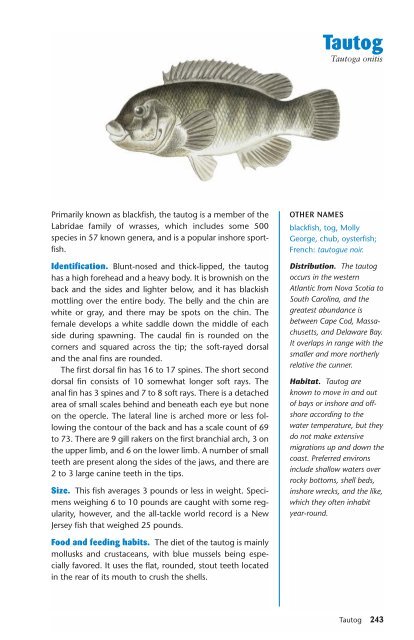Ken Schultz's Field Guide to Saltwater Fish - Macaw Pets store
Ken Schultz's Field Guide to Saltwater Fish - Macaw Pets store
Ken Schultz's Field Guide to Saltwater Fish - Macaw Pets store
You also want an ePaper? Increase the reach of your titles
YUMPU automatically turns print PDFs into web optimized ePapers that Google loves.
Primarily known as blackfish, the tau<strong>to</strong>g is a member of the<br />
Labridae family of wrasses, which includes some 500<br />
species in 57 known genera, and is a popular inshore sportfish.<br />
Identification. Blunt-nosed and thick-lipped, the tau<strong>to</strong>g<br />
has a high forehead and a heavy body. It is brownish on the<br />
back and the sides and lighter below, and it has blackish<br />
mottling over the entire body. The belly and the chin are<br />
white or gray, and there may be spots on the chin. The<br />
female develops a white saddle down the middle of each<br />
side during spawning. The caudal fin is rounded on the<br />
corners and squared across the tip; the soft-rayed dorsal<br />
and the anal fins are rounded.<br />
The first dorsal fin has 16 <strong>to</strong> 17 spines. The short second<br />
dorsal fin consists of 10 somewhat longer soft rays. The<br />
anal fin has 3 spines and 7 <strong>to</strong> 8 soft rays. There is a detached<br />
area of small scales behind and beneath each eye but none<br />
on the opercle. The lateral line is arched more or less following<br />
the con<strong>to</strong>ur of the back and has a scale count of 69<br />
<strong>to</strong> 73. There are 9 gill rakers on the first branchial arch, 3 on<br />
the upper limb, and 6 on the lower limb. A number of small<br />
teeth are present along the sides of the jaws, and there are<br />
2 <strong>to</strong> 3 large canine teeth in the tips.<br />
Size. This fish averages 3 pounds or less in weight. Specimens<br />
weighing 6 <strong>to</strong> 10 pounds are caught with some regularity,<br />
however, and the all-tackle world record is a New<br />
Jersey fish that weighed 25 pounds.<br />
Food and feeding habits. The diet of the tau<strong>to</strong>g is mainly<br />
mollusks and crustaceans, with blue mussels being especially<br />
favored. It uses the flat, rounded, s<strong>to</strong>ut teeth located<br />
in the rear of its mouth <strong>to</strong> crush the shells.<br />
Tau<strong>to</strong>g<br />
Tau<strong>to</strong>ga onitis<br />
OTHER NAMES<br />
blackfish, <strong>to</strong>g, Molly<br />
George, chub, oysterfish;<br />
French: tau<strong>to</strong>gue noir.<br />
Distribution. The tau<strong>to</strong>g<br />
occurs in the western<br />
Atlantic from Nova Scotia <strong>to</strong><br />
South Carolina, and the<br />
greatest abundance is<br />
between Cape Cod, Massachusetts,<br />
and Delaware Bay.<br />
It overlaps in range with the<br />
smaller and more northerly<br />
relative the cunner.<br />
Habitat. Tau<strong>to</strong>g are<br />
known <strong>to</strong> move in and out<br />
of bays or inshore and offshore<br />
according <strong>to</strong> the<br />
water temperature, but they<br />
do not make extensive<br />
migrations up and down the<br />
coast. Preferred environs<br />
include shallow waters over<br />
rocky bot<strong>to</strong>ms, shell beds,<br />
inshore wrecks, and the like,<br />
which they often inhabit<br />
year-round.<br />
Tau<strong>to</strong>g 243


